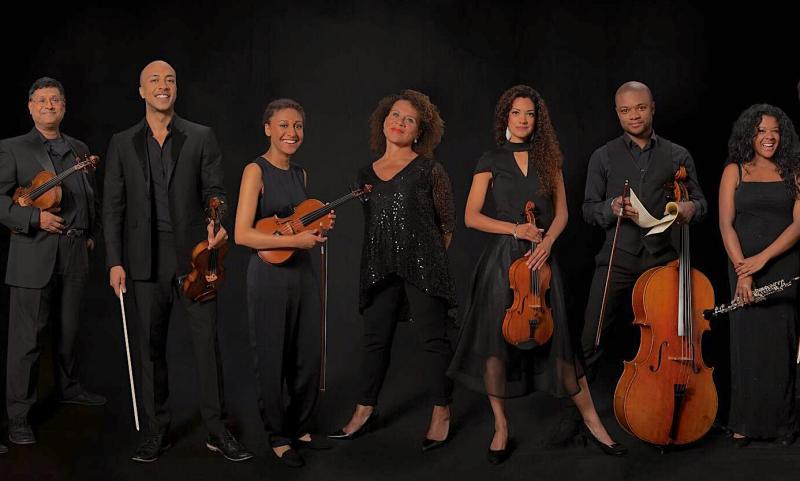Goodyear, Chineke! Orchestra, Marshall, Symphony Hall, Birmingham Review - engaging and uplifting | reviews, news & interviews
Goodyear, Chineke! Orchestra, Marshall, Symphony Hall, Birmingham Review - engaging and uplifting
Goodyear, Chineke! Orchestra, Marshall, Symphony Hall, Birmingham Review - engaging and uplifting
Joy and sparkle from this youthful band

Having played their first concert just four years ago, the Chineke! Orchestra gave a rousing, exuberant performance for an ensemble still in its infancy. It’s a young orchestra, not just in the sense of only being founded a few years ago, but one that comprises many young players too. Though its youthful passion and energy was very much to the fore, there were some points in Edvard Grieg’s Peer Gynt Suite No 1 when a lack of experience let them down.
Stewart Goodyear’s Callaloo – A Caribbean Suite for Piano and Orchestra had all the joy and colour of a Caribbean carnival, with the composer himself at the keyboard. Named after a Caribbean dish that blends flavours and spices, the piece mixes musical influences, from calypso to jazz, Afro-Cuban and Jamican folk, as well as classical. The first movement, "Panorama", is inspired by steel pan groups playing medleys of calypso songs, and seemed to exude sunshine in this high-spirited performance. The second, "Mento", is an homage to the Jamican musical style of the same name and features driven rhythms from strings and horn.  Goodyear’s playing (the pianist/composer pictured above by Anita Svonar) switched from punchy and flamboyant to tender and lyrical for the third movement, "Ballad", before giving bright splashes of colour to his cadenza. Moving straight into the final movement, "Soca", which takes its name from the Carnival’s grand finale, the orchestra played with an infectious energy, with brilliant trumpets and zesty percussion. Conductor Wayne Marshall seemed almost to be dancing on the podium as he brought the exhilarating final movement to an end.
Goodyear’s playing (the pianist/composer pictured above by Anita Svonar) switched from punchy and flamboyant to tender and lyrical for the third movement, "Ballad", before giving bright splashes of colour to his cadenza. Moving straight into the final movement, "Soca", which takes its name from the Carnival’s grand finale, the orchestra played with an infectious energy, with brilliant trumpets and zesty percussion. Conductor Wayne Marshall seemed almost to be dancing on the podium as he brought the exhilarating final movement to an end.
The audience was a particularly enthusiastic one, giving rapturous applause at the end of every movement of every piece. Even the stage manager was heartily clapped as he came on to lift the piano lid ahead of Goodyear’s performance. Though clapping in between movements is, in today’s classical music circles, strictly Not. The. Done. Thing., the fact that this orchestra brought in a new audience, unused to the unwritten conventions of a concert hall, can only be a positive, and perhaps other groups could take note.
To end the programme, the orchestra captured the dark, brooding atmosphere of Dvořák’s Seventh Symphony. Though it wasn’t without its wobbles, the problems of the earlier Grieg had all but vanished, and the orchestra played with a much more mature sound than in the earlier works. Marshall took measured control over the music’s ebb and flow, not letting its energies bubble over. The lilting of the Scherzo lent the music a joyous feel despite its minor key, and the finale was played with a strong, exacting sound.
rating
Explore topics
Share this article
The future of Arts Journalism
You can stop theartsdesk.com closing!
We urgently need financing to survive. Our fundraising drive has thus far raised £49,000 but we need to reach £100,000 or we will be forced to close. Please contribute here: https://gofund.me/c3f6033d
And if you can forward this information to anyone who might assist, we’d be grateful.

Subscribe to theartsdesk.com
Thank you for continuing to read our work on theartsdesk.com. For unlimited access to every article in its entirety, including our archive of more than 15,000 pieces, we're asking for £5 per month or £40 per year. We feel it's a very good deal, and hope you do too.
To take a subscription now simply click here.
And if you're looking for that extra gift for a friend or family member, why not treat them to a theartsdesk.com gift subscription?
more Classical music
 BBC Proms: Barruk, Norwegian Chamber Orchestra, Kuusisto review - vague incantations, precise laments
First-half mix of Sámi songs and string things falters, but Shostakovich scours the soul
BBC Proms: Barruk, Norwegian Chamber Orchestra, Kuusisto review - vague incantations, precise laments
First-half mix of Sámi songs and string things falters, but Shostakovich scours the soul
 BBC Proms: Alexander’s Feast, Irish Baroque Orchestra, Whelan review - rapturous Handel fills the space
Pure joy, with a touch of introspection, from a great ensemble and three superb soloists
BBC Proms: Alexander’s Feast, Irish Baroque Orchestra, Whelan review - rapturous Handel fills the space
Pure joy, with a touch of introspection, from a great ensemble and three superb soloists
 BBC Proms: Moore, LSO, Bancroft review - the freshness of morning wind and brass
English concert band music...and an outlier
BBC Proms: Moore, LSO, Bancroft review - the freshness of morning wind and brass
English concert band music...and an outlier
 Willis-Sørensen, Ukrainian Freedom Orchestra, Wilson, Cadogan Hall review - romantic resilience
Passion, and polish, from Kyiv's musical warriors
Willis-Sørensen, Ukrainian Freedom Orchestra, Wilson, Cadogan Hall review - romantic resilience
Passion, and polish, from Kyiv's musical warriors
 BBC Proms: Faust, Gewandhausorchester Leipzig, Nelsons review - grace, then grandeur
A great fiddler lightens a dense orchestral palette
BBC Proms: Faust, Gewandhausorchester Leipzig, Nelsons review - grace, then grandeur
A great fiddler lightens a dense orchestral palette
 BBC Proms: Jansen, Royal Concertgebouw Orchestra, Mäkelä review - confirming a phenomenon
Second Prom of a great orchestra and chief conductor in waiting never puts a foot wrong
BBC Proms: Jansen, Royal Concertgebouw Orchestra, Mäkelä review - confirming a phenomenon
Second Prom of a great orchestra and chief conductor in waiting never puts a foot wrong
 BBC Proms: Royal Concertgebouw Orchestra, Mäkelä review - defiantly introverted Mahler 5 gives food for thought
Chief Conductor in Waiting has supple, nuanced chemistry with a great orchestra
BBC Proms: Royal Concertgebouw Orchestra, Mäkelä review - defiantly introverted Mahler 5 gives food for thought
Chief Conductor in Waiting has supple, nuanced chemistry with a great orchestra
 Dunedin Consort, Butt / D’Angelo, Muñoz, Edinburgh International Festival 2025 review - tedious Handel, directionless song recital
Ho-hum 'comic' cantata, and a song recital needing more than a beautiful voice
Dunedin Consort, Butt / D’Angelo, Muñoz, Edinburgh International Festival 2025 review - tedious Handel, directionless song recital
Ho-hum 'comic' cantata, and a song recital needing more than a beautiful voice
 Classical CDs: Dungeons, microtones and psychic distress
This year's big anniversary celebrated with a pair of boxes, plus clarinets, pianos and sacred music
Classical CDs: Dungeons, microtones and psychic distress
This year's big anniversary celebrated with a pair of boxes, plus clarinets, pianos and sacred music
 BBC Proms: Liu, Philharmonia, Rouvali review - fine-tuned Tchaikovsky epic
Sounds perfectly finessed in a colourful cornucopia
BBC Proms: Liu, Philharmonia, Rouvali review - fine-tuned Tchaikovsky epic
Sounds perfectly finessed in a colourful cornucopia
 BBC Proms: Suor Angelica, LSO, Pappano review - earthly passion, heavenly grief
A Sister to remember blesses Puccini's convent tragedy
BBC Proms: Suor Angelica, LSO, Pappano review - earthly passion, heavenly grief
A Sister to remember blesses Puccini's convent tragedy
 BBC Proms: A Mass of Life, BBCSO, Elder review - a subtle guide to Delius's Nietzschean masterpiece
Mark Elder held back from blasting the audience with a wall of sound
BBC Proms: A Mass of Life, BBCSO, Elder review - a subtle guide to Delius's Nietzschean masterpiece
Mark Elder held back from blasting the audience with a wall of sound

Add comment